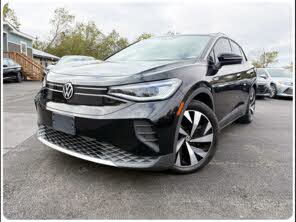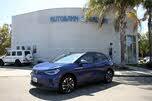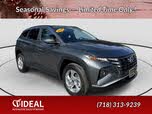2021 Volkswagen ID.4 vs 2022 Hyundai Tucson
Overview | |
MSRP$39,995 | MSRP$25,800 |
Listings396 | Listings1954 |
Ratings & Reviews | |
User Reviews | User Reviews |
Expert reviews7.3 out of 10 | Expert reviews8.3 out of 10 |
Pros
Cons
| Pros
Cons
|
2021 Volkswagen ID.4 Reviews SummaryThe “Dieselgate” emissions scandal forced Volkswagen to double down on electric cars, and now we’re finally seeing the first result of that: the 2021 Volkswagen ID.4 electric crossover. VW has made an electric car before, but its last attempt, the e-Golf, was built to satisfy emissions standards, not rack up sales. It was barely advertised, and it was sold only in certain states. That’s not the case with the ID.4, which will be available nationwide and will even be built in Tennessee starting in 2022. Volkswagen views the ID.4 as a rival not to other EVs, but to mainstream gasoline vehicles like the Honda CR-V and Toyota RAV4. Being late to the party means there are already several other EVs trying to coax new-car buyers away from internal combustion, however. If you want a reasonably-priced EV, the Nissan Leaf, Hyundai Kona Electric, and Kia Niro EV already exist, and General Motors just announced the 2022 Chevrolet Bolt EUV—a new variant of the Chevy Bolt EV with a crossover body style similar to the Volkswagen. We tested an ID.4 1st Edition, which commemorates the car’s launch, and an ID.4 PRO S with all-wheel drive (AWD). The 1st Edition is a limited-edition model that has already sold out, but it’s mechanically identical to the ID.4 Pro S AWD, albeit with power sent only to the rear wheels. | |
2022 Hyundai Tucson Reviews SummaryThe redesigned 2022 Hyundai Tucson has to offer a high-tech cabin, comfortable ride, competent engine lineup, and spacious cargo area to keep up with the Joneses in the hot-selling and competitive compact SUV class. It does that, and more, with Hyundai giving plenty of compelling reasons to take the 2022 Tucson for a test drive. | |
Popular Features & Specs | |
Engine201 hp Electric | Engine2.5L 187 hp I4 |
Drive TrainRWD | Drive TrainFWD |
Seating Capacity5 | Seating Capacity5 |
Horsepower | Horsepower187 hp @ 6100 rpm |
EV Battery Capacity82 kWh | EV Battery Capacity |
MPG City104 | MPG City26 |
MPG Highway89 | MPG Highway33 |
Battery Charge Time (240V)8 hours | Battery Charge Time (240V) |
Engine | |
Engine Name201 hp Electric | Engine Name2.5L 187 hp I4 |
Torque | Torque178 lb-ft @ 4000 rpm |
Horsepower | Horsepower187 hp @ 6100 rpm |
Battery Charge Time (240V)8 hours | Battery Charge Time (240V) |
DrivetrainRWD | DrivetrainFWD |
Fuel Economy | |
EV Battery Capacity82 kWh | EV Battery Capacity |
MPG City104 | MPG City26 |
MPG Highway89 | MPG Highway33 |
Interior | |
Seating Capacity5 | Seating Capacity5 |
Safety | |
Front Crash Overall5 | Front Crash Overall4 |
Side Crash Overall5 | Side Crash Overall5 |
Dimensions & Capacity | |
Cargo Space30.3 cu ft | Cargo Space38.7 cu ft |
Curb Weight4517 lbs | Curb Weight3329 lbs |
Height64.4 in | Height65.6 in |
Length180.5 in | Length182.3 in |
Width72.9 in | Width73.4 in |
Wheelbase108.9 in | Wheelbase108.5 in |
Maximum Payload1347 lbs | Maximum Payload1301 lbs |
Number of doors4 | Number of doors4 |
Maximum Towing Capacity | Maximum Towing Capacity2000 lbs |
Standard Towing Capacity | Standard Towing Capacity2000 lbs |
Overview | ||
MSRP | $39,995 | $25,800 |
Listings | ||
Ratings & Reviews | ||
User reviews | ||
Expert reviews | 7.3 out of 10Read full review | 8.3 out of 10Read full review |
Pros & cons | Pros
Cons
| Pros
Cons
|
Summary | The “Dieselgate” emissions scandal forced Volkswagen to double down on electric cars, and now we’re finally seeing the first result of that: the 2021 Volkswagen ID.4 electric crossover. VW has made an electric car before, but its last attempt, the e-Golf, was built to satisfy emissions standards, not rack up sales. It was barely advertised, and it was sold only in certain states. That’s not the case with the ID.4, which will be available nationwide and will even be built in Tennessee starting in 2022. Volkswagen views the ID.4 as a rival not to other EVs, but to mainstream gasoline vehicles like the Honda CR-V and Toyota RAV4. Being late to the party means there are already several other EVs trying to coax new-car buyers away from internal combustion, however. If you want a reasonably-priced EV, the Nissan Leaf, Hyundai Kona Electric, and Kia Niro EV already exist, and General Motors just announced the 2022 Chevrolet Bolt EUV—a new variant of the Chevy Bolt EV with a crossover body style similar to the Volkswagen. We tested an ID.4 1st Edition, which commemorates the car’s launch, and an ID.4 PRO S with all-wheel drive (AWD). The 1st Edition is a limited-edition model that has already sold out, but it’s mechanically identical to the ID.4 Pro S AWD, albeit with power sent only to the rear wheels. | The redesigned 2022 Hyundai Tucson has to offer a high-tech cabin, comfortable ride, competent engine lineup, and spacious cargo area to keep up with the Joneses in the hot-selling and competitive compact SUV class. It does that, and more, with Hyundai giving plenty of compelling reasons to take the 2022 Tucson for a test drive. |
Video | ||
Popular Features & Specs | ||
Engine | 201 hp Electric | 2.5L 187 hp I4 |
Drive Train | RWD | FWD |
Seating Capacity | 5 | 5 |
Horsepower | 187 hp @ 6100 rpm | |
EV Battery Capacity | 82 kWh | |
MPG City | 104 | 26 |
MPG Highway | 89 | 33 |
Battery Charge Time (240V) | 8 hours | |
Engine | ||
Engine Name | 201 hp Electric | 2.5L 187 hp I4 |
Torque | 178 lb-ft @ 4000 rpm | |
Horsepower | 187 hp @ 6100 rpm | |
Battery Charge Time (240V) | 8 hours | |
Drivetrain | RWD | FWD |
Fuel Economy | ||
EV Battery Capacity | 82 kWh | |
MPG City | 104 | 26 |
MPG Highway | 89 | 33 |
Interior | ||
Seating Capacity | 5 | 5 |
Safety | ||
Front Crash Overall | 5 | 4 |
Side Crash Overall | 5 | 5 |
Dimensions & Capacity | ||
Cargo Space | 30.3 cu ft | 38.7 cu ft |
Curb Weight | 4517 lbs | 3329 lbs |
Height | 64.4 in | 65.6 in |
Length | 180.5 in | 182.3 in |
Width | 72.9 in | 73.4 in |
Wheelbase | 108.9 in | 108.5 in |
Maximum Payload | 1347 lbs | 1301 lbs |
Number of doors | 4 | 4 |
Maximum Towing Capacity | 2000 lbs | |
Standard Towing Capacity | 2000 lbs | |
The 2021 Volkswagen ID.4 was designed from the ground up as an electric vehicle (EV), showcasing a distinctive look that set it apart from Volkswagen's gasoline models. It replaced the straight lines and sharp angles of the Tiguan and Atlas with a streamlined profile and wheels pushed out to the corners. The ID.4 was part of VW’s EV-specific MEB platform, following the European-market ID.3 hatchback. Despite its SUV-like styling, the ID.4 didn’t quite look like an SUV, similar to other EV crossovers like the Chevy Bolt EUV and Tesla Model Y. The interior combined Volkswagen’s minimalism with a tech-focused aesthetic, featuring piano black and matte plastic finishes. Standard features included a leather-wrapped steering wheel and cloth seats, with leatherette upholstery available on higher trims.
The 2022 Hyundai Tucson rode on a new platform and was offered in the U.S. as a long-wheelbase model with two rows of seating and expanded cargo space. The Tucson featured Hyundai’s new parametric grille, hiding LED daytime running lights, Bi-LED headlights, and LED front turn signals. The side profile mirrored the Hyundai Elantra’s design, with a silver D-pillar creating a floating roof effect. The rear had toothy taillights illuminated by LEDs. Depending on the trim, the Tucson rode on 17- or 19-inch wheels, with high-end trims featuring premium fascias, gloss black pillars, and a panoramic sunroof. The interior was well-appointed, with standard stain- and odor-resistant cloth seats, and available sport combination and leather-trimmed seats. Horizontal lines across the dashboard and an uncluttered aesthetic gave the cabin a spacious feel.

















At launch, the 2021 Volkswagen ID.4 was available with a single rear-mounted electric motor producing 201 horsepower and 229 pound-feet of torque, powered by an 82-kilowatt-hour battery pack. It was the first rear-wheel drive (RWD) Volkswagen passenger car sold in the U.S. since the Beetle. An all-wheel-drive (AWD) version with a second electric motor arrived later in 2021, boosting power to 295 horsepower and 339 pound-feet of torque. The ID.4 was tuned for comfort rather than sporty handling, with a smooth ride over bumps but noticeable body roll in corners. Unlike many EVs, the ID.4 did not offer aggressive regenerative braking for one-pedal driving, relying more on friction brakes to provide a familiar experience for drivers transitioning from gasoline cars.
The 2022 Hyundai Tucson came in two powertrain variants: a 2.5-liter direct-injected four-cylinder engine and a turbocharged 1.6-liter four-cylinder hybrid engine. The ICE engine delivered 187 horsepower and 178 pound-feet of torque, while the hybrid offered 226 combined horsepower and 258 pound-feet of torque. The hybrid powertrain made the Tucson more powerful than competitors like the Ford Escape Hybrid and Toyota RAV4 Hybrid. AWD was standard on the hybrid and available on ICE models. The Tucson Hybrid achieved impressive fuel economy, with up to 38 mpg combined. A plug-in hybrid version with a 13.8-kilowatt-hour battery and an estimated 261 horsepower was also announced, promising around 25 miles of all-electric range.
The 2021 Volkswagen ID.4 offered more front and rear headroom than competitor EVs, though legroom was average for the segment. It provided 30.3 cubic feet of cargo space with the rear seats in place and 64.2 cubic feet with the seats folded, more than several EV competitors but less than the Honda CR-V and Toyota RAV4. The ID.4 lacked a front trunk (frunk), but the interior felt spacious, with good forward visibility. The console was narrow, offering limited storage space for larger items. Standard heated steering wheel and front seats helped maintain cabin heat efficiently.
The 2022 Hyundai Tucson featured a spacious interior with a six-way power-adjustable driver’s seat standard, and an eight-way version available on higher trims. The new platform allowed for more passenger and cargo space, with the rear seats offering two inches more legroom than the RAV4. The Tucson’s 74.8 cubic-foot cargo area was comparable to the Forester, RAV4, and CR-V, and significantly larger than the Escape. The rear seats were a 60-40 split-folding bench, with a dual-level cargo floor on ICE models. A hands-free liftgate was available on mid-grade models and up.
The 2021 Volkswagen ID.4 came with a standard 10-inch touchscreen (a 12-inch screen was optional) with wireless Apple CarPlay and Android Auto. A 5.3-inch display screen served as the instrument cluster, and haptic touchpads replaced nearly all switchgear. The control setup was challenging to use due to the lack of tactile feedback. The ID.4 also featured a natural-language voice-control system and ID.Light, a light strip at the base of the windshield that communicated information to the driver. The touchscreen was well-positioned with smart-looking graphics and easy-to-navigate menus.
The 2022 Hyundai Tucson offered an 8-inch infotainment touchscreen, a six-speaker audio system, wireless Android Auto and Apple CarPlay, HD Radio, and two USB ports as standard. Higher trims added satellite radio, Blue Link mobile app compatibility, additional USB outlets, rear air conditioning vents, and dual-zone automatic climate control. A 10.25-inch touchscreen was available, but required plugging in devices for Apple CarPlay and Android Auto. The larger screen was embedded within a flat plastic head unit, making it difficult to find the right touchpoints while driving. Steering wheel controls and voice commands were more heavily relied upon.
The 2021 Volkswagen ID.4 received the highest-level Top Safety Pick+ designation from the IIHS and a five-star rating from the NHTSA for the RWD model. Standard driver aids included forward-collision warning, automatic emergency braking, blind-spot monitoring, lane-keep assist, park distance control, automatic high beams, and adaptive cruise control. Travel Assist and Emergency Assist were new features for 2021, with Travel Assist providing automated lane centering and Emergency Assist stopping the car if the driver was incapacitated.
The 2022 Hyundai Tucson had not been tested by the IIHS or NHTSA. The Hyundai SmartSense Safety Feature suite included forward collision-avoidance assist, lane-keep assist, automatic high beams, driver attention monitor, rear occupant alert, speed limit assist, and leading vehicle departure alert as standard. Optional features included blind-spot warning, rear cross-traffic alert, adaptive cruise control, surround-view camera system, and remote parking assist. Hyundai offered a comprehensive warranty package, including a 10-year/100,000-mile powertrain limited warranty and 3 years/36,000 miles of complimentary maintenance.
CarGurus highlights

According to CarGurus experts, the overall rating for the 2021 Volkswagen ID.4 is 7.3 out of 10, while the 2022 Hyundai Tucson scores 8.3 out of 10. Based on these ratings, the 2022 Hyundai Tucson is the better choice, offering more powertrain options, a spacious and well-appointed interior, and a comprehensive suite of safety features.
Choose the 2021 Volkswagen ID.4 if:
- You prefer a distinctive EV design with a streamlined profile.
- You value a smooth and comfortable ride over sporty handling.
- You want a vehicle with advanced voice-control and infotainment features.
Choose the 2022 Hyundai Tucson if:
- You need a spacious and well-appointed interior for passengers and cargo.
- You prioritize fuel efficiency and power with hybrid and plug-in hybrid options.
- You want a comprehensive suite of safety features and a strong warranty package.
CarGurus highlights

According to CarGurus experts, the overall rating for the 2021 Volkswagen ID.4 is 7.3 out of 10, while the 2022 Hyundai Tucson scores 8.3 out of 10. Based on these ratings, the 2022 Hyundai Tucson is the better choice, offering more powertrain options, a spacious and well-appointed interior, and a comprehensive suite of safety features.
Choose the 2021 Volkswagen ID.4 if:
Shop Now- You prefer a distinctive EV design with a streamlined profile.
- You value a smooth and comfortable ride over sporty handling.
- You want a vehicle with advanced voice-control and infotainment features.
Choose the 2022 Hyundai Tucson if:
Shop Now- You need a spacious and well-appointed interior for passengers and cargo.
- You prioritize fuel efficiency and power with hybrid and plug-in hybrid options.
- You want a comprehensive suite of safety features and a strong warranty package.

By: CarGurus + AI
At CarGurus, our team of experienced automotive writers remain at the heart of our content operation, conducting hands-on car tests and writing insightful guides that are backed by years of industry experience. To complement this, we are harnessing AI to make our content offering more diverse and more helpful to shoppers than ever. To achieve this, our AI systems are based exclusively on CarGurus content, ratings and data, so that what we produce is both unique to CarGurus, and uniquely helpful to car shoppers.






































